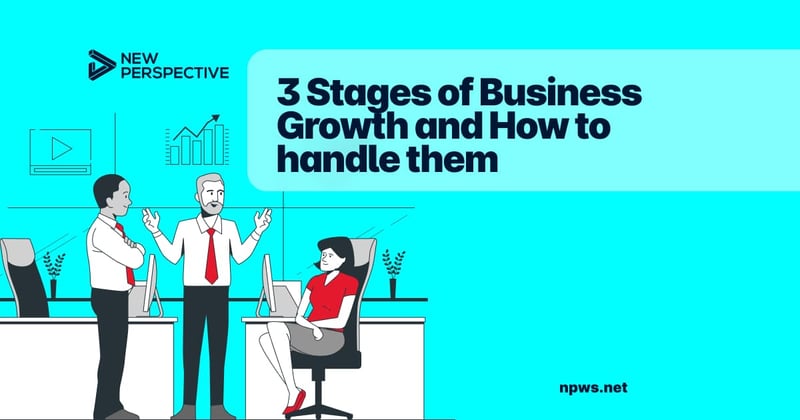3 Critical Stages of Business Growth & How to Handle Them

Every person is unique. And yet, each one of us goes through the same stages of growth, facing similar challenges and pressures that come with each of these phases: childhood, adolescence, adulthood, and seniority. Businesses are like people. As they mature, they progress through several stages of business growth that force them to reconsider, adjust, or completely change the way they operate.
In business, as in life, there’s a time for everything. Knowing which stage of growth your business is in will help you make the right decisions at the right time and take your business to the next level.
How Many Stages of Business Growth Are There?
While most experts agree on the basic concept of the universal stages of growth, it’s hard to draw a precise line between each of these stages. Depending on who you talk to, you will hear slightly different definitions, name conventions, and classifications.
The business life cycle framework, for example, lists five stages: launch, growth, shake-out, maturity, and decline. This school of thought is popular with serial entrepreneurs looking to grow a business and sell it at its peak.
Entrepreneurs and leaders who strive to build a legacy with their business have a slightly different perspective. They often list 4 universal stages of business growth: startup, growth, expansion, and maturity, or enterprise stage.
What are the 3 stages of business growth?
For the sake of simplicity and practicality, we are going to focus on three stages of business growth: early growth, stagnant growth, and renewal/decline. Why? Decisions made at these times will have a crucial effect on the future of your business. At New Perspective, we help businesses at these critical stages of growth to make decisions that will help them grow and succeed.
Each stage comes with its own unique challenges to solve. To help you navigate through this shaky terrain, we will explain the common challenges—and possible solutions—that come with each phase of growth.
The Early Growth Stage – Startups & New Businesses
Every beginning is hard. You’ve invested time, energy, and cash flow into a business idea you believe in. Now, it’s all about the execution.
The clock is ticking:
- Investors want to see opportunities in your pipeline
- You need a certain number of quality leads to support your sales target
- You may have to prepare for launch at big events, such as trade shows or virtual events
As an early stage business owner, you need to prove your idea can work. If you’re successful, you will generate enough revenue to expand the market on your own, or you will create a strong case for the right investors to help you scale up. Marketing will play a crucial role in this phase.
You will need to:
Do your research.
Validate your business model hypothesis by conducting customer and market research. Before you’re ready to launch full-scale customer acquisition, you need to have a detailed profile of your ideal customer (or customers) and a clear image of your position in the competitive landscape. These insights will inform your marketing and brand strategy.
Create a marketing strategy
Your marketing strategy should include: clear, measurable, and time-bound business goals; the corresponding marketing goals; the findings from the research phase (target audience profiles, competitor landscape, and market analysis); your go-to-market plan (a series of tactics, channels, and an outline of the customer experience that will support your objectives); and a definition of key performance indicators that will help you make informed decisions when you’re under pressure.
Start to build a brand
There may be hundreds or thousands of businesses operating in your industry. How do you stand out? If you want to succeed, you need distinctive brand assets that communicate the value of your offering. Put your company mission, vision, and core values to paper.
Together with the consumer and market insights gained in the research phase, these elements will help your business develop a unique, powerful brand. As soon as you define your brand identity, update all of your assets—be sure to pay special attention to your website.
Set up tools and processes
While these may seem unnecessary at the moment, they will pay off when your team starts growing explosively. Choose your sales and marketing toolkit carefully: find the best tools to facilitate your customer acquisition and support when your business takes off. These can include CRM, CMS, data gathering and analytics, project management tools, and more. Create clear processes for your sales, marketing, and support teams to ensure consistency and quality.
The Maturity Stage – Stagnation or Steady Growth
If you make it to this phase, congratulations! Your business is one of roughly 10% that manage to survive post early growth. You have managed to turn a profit, attract additional investments, or both. You have gained a customer base and maybe even some attention from the industry press. You’ve come a long way, but this is no time to rest on your laurels.
We have found that, for many businesses, this is the stage where growth may begin to stagnate. After your explosive initial rapid growth, your numbers are starting to stabilize, or even go down:
- You fail to hit your monthly, quarterly, or yearly targets
- The industry may be growing faster than you
- Your competitors are growing faster than you
No matter how successful your business, your growth is eventually going to slow down. When that happens, it’s time to make some changes:
Evaluate your strategy
Based on ongoing market and customer research and the goals you’ve set, reconsider your business and marketing strategy. Is there an opportunity to open a new market?
Does it make sense to expand your offering? Maybe there’s room for both. By keeping a close eye on the market, the competition, and the target audience, you will identify new growth opportunities and adjust your strategy and tactics accordingly.
Revisit and update your brand
Your business has changed over the years. Does your visual identity still capture the essence of your brand? Does your website meet the conversion goals? You will find answers to these questions by looking at the KPIs and talking to your customers directly. A refreshed brand and new digital assets can spark growth.
Invest in marketing and customer experience
Identify gaps and make improvements in your customer journey to increase conversions. Create experiences that bring your brand and the benefits of your product or service to life. Only think about expanding your audience if you’re meeting your conversion goals and you’ve saturated your original target audience. Let the data guide your decisions.
Consider bringing on external partners
Initial years of success, established procedures and ways of thinking, and various biases often leave mature businesses blindsided. In addition to more specialized expertise, working with external partners can breathe new energy and bring fresh insights into your business. It will also let your team double down on what they do best.
The Decline/Renewal Stage of Business Growth
Simply reaching this phase is a major achievement. By this time, your business has become one of the leading and most reputable companies in your market—but that doesn’t mean you’re safe.
The most dangerous thing at this stage is to become romantic about the way you used to do business. What got you here isn’t likely to get you there. New technologies, consumer preferences, or market conditions can steer any company into irrelevancy. In fact, this may already be happening:
- Has your industry been in decline for several years?
- Are you losing ground to new competitors?
- Are changes in society and technology hurting your business?
If none of these statements are true, your business still needs to adopt a culture of innovation, keep investing in customer and market research, and invest in research and development.
If, however, any of these statements are true, it may be time to embrace radical change and make a pivot. Think Blockbuster in the early 2000s: it’s time to get disruptive or get disrupted.
Question everything
Take a deep look at every aspect of your business, from finances and operations to marketing and sales. Talk to customers, research the competition, and analyze the market; find out what’s working, what’s not, and what could work.
Develop alternative strategies
Based on this information, build several alternative strategies that could better meet the demands of the market. These can be minor tweaks or complete shifts in the way you do business. Maybe you’ll simply need to expand your offering, or you’ll need to reinvent your entire business.
Create a new strategy
Once you develop possible alternatives, create a list of hypotheses you need to validate to prove the viability of each potential strategy. Use the data to guide your final decision.
Make the switch
Depending on the scope of change required, the length and the scope of the transition will vary. You will, however, need to reassess every strategic decision and make sure it’s compatible with the new path.
Communicate
Finally, you will have to make your change public. Communicate proactively and make sure your every asset, physical or digital, is a perfect reflection of your new vision.
Is it time for your business to pivot? As businesses across every market and industry face uncertainty in the wake of COVID-19, it may be time for a big change. Evaluate your business outlook in the light of global uncertainty and develop possible pivot paths using this simple tool. It’s completely free.
Why These 3 Stages of Business Growth Matter
Every business is different. Some of the challenges your business faces are directly related to your industry or position in the market. But there are certain aspects in which all businesses are alike: every successful company inevitably goes through common stages of growth. Each of these phases comes with a set of similar challenges that the large company or small businesses has to address.
By learning from the mistakes—and successes—of other companies, you can anticipate issues and source solutions that can take your business forward. For example:
- If you’re just starting, focus on establishing the right procedures and setting up the infrastructure that will help you scale your business smoothly
- If your growth starts to slow down or stagnate, look for ways to open new markets or expand your offering
- When your business gets disrupted, embrace change: rethink the core of your business and create a new, future-proof strategy for success
If there’s one thing that businesses in all growth phases of a business have in common, it’s that none of them can afford to get complacent. Just ask Blockbuster.




